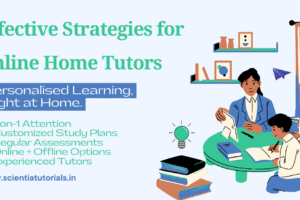Assessing Student Progress: Essential Tips for Home Tutors
Introduction
As a home tutor, one of the most critical aspects of your role is to assess student progress effectively. Assessment not only helps gauge how well a student understands the material but also informs future teaching strategies and goals. It can be a powerful tool for both the tutor and the student, offering insights into strengths, weaknesses, and areas for improvement. This article will provide home tutors with practical tips and strategies for assessing student progress, ensuring that each learner can achieve their academic potential.
1. Understanding the Importance of Assessment
Before diving into the specific strategies for assessing student progress, it’s crucial to understand why assessment is vital in the tutoring process.
a. Identifying Learning Gaps
Assessments help tutors identify gaps in knowledge or skills. This understanding enables targeted instruction, focusing on areas that require more attention.
b. Tracking Progress
Regular assessments allow tutors to track student progress over time. This tracking provides both tutors and students with a clear picture of improvement and areas that may need additional focus.
c. Building Student Confidence
When students see their progress through assessments, it can significantly boost their confidence and motivation. Acknowledging improvements, no matter how small, encourages students to continue striving for success.
2. Types of Assessments for Home Tutors
There are various types of assessments that home tutors can employ. Understanding the differences between these methods can help you choose the most effective strategies for your students.
a. Formative Assessments
Formative assessments are ongoing evaluations that occur during the learning process. They are often informal and help tutors understand how well a student is grasping the material.
- Examples: Quizzes, verbal questioning, homework checks, and classroom discussions.
b. Summative Assessments
Summative assessments occur at the end of a learning period, such as a unit or semester. They evaluate overall understanding and retention of material.
- Examples: Final exams, projects, or standardized tests.
c. Diagnostic Assessments
Diagnostic assessments help identify a student’s strengths and weaknesses before beginning a new topic or unit. They can guide the tutor in customizing instruction based on individual needs.
- Examples: Pre-tests, skill inventories, and self-assessments.
d. Self-Assessment
Encouraging students to assess their learning can promote self-reflection and responsibility for their education. Self-assessment helps students identify their own strengths and weaknesses.
- Examples: Journals, learning logs, or checklists.
3. Establishing Clear Learning Objectives
Before assessing student progress, it’s essential to set clear learning objectives. Well-defined objectives provide a roadmap for both the tutor and the student, ensuring that assessments are aligned with desired outcomes.
a. SMART Goals
Use the SMART framework to create objectives that are Specific, Measurable, Achievable, Relevant, and Time-bound. This clarity helps both tutor and student understand what is expected.
- Example: “By the end of this unit, the student will be able to solve linear equations with 80% accuracy on assessments.”
b. Communicate Objectives
Clearly communicate the learning objectives to students at the beginning of each session or unit. This transparency helps students understand the focus of their learning and assessment.
4. Incorporating a Variety of Assessment Methods
Using a variety of assessment methods can provide a more comprehensive understanding of a student’s progress and learning style. Different students may respond better to different types of assessments.
a. Quizzes and Tests
Regular quizzes and tests can provide valuable data on student understanding. These assessments can be informal or formal, depending on the context.
- Tip: Create a mix of question types (multiple-choice, short answer, problem-solving) to assess different levels of understanding.
b. Observational Assessments
Observing students during tutoring sessions can yield insights into their understanding and engagement levels. Take notes on their participation, questions, and overall demeanor.
- Tip: Use checklists to document specific behaviors or skills you are monitoring during the session.
c. Projects and Presentations
Assigning projects or presentations allows students to demonstrate their understanding creatively and critically. These assessments can also develop research and presentation skills.
- Example: Have students create a presentation on a topic they’ve studied, encouraging them to express their understanding in their own words.
d. Peer Assessment
Encouraging peer assessment can foster collaboration and critical thinking skills. Allow students to review each other’s work, providing constructive feedback.
- Tip: Teach students how to provide specific, positive feedback and how to accept it gracefully.
5. Providing Constructive Feedback
Feedback is a crucial component of the assessment process. Constructive feedback helps students understand their performance and areas for improvement.
a. Be Specific
When providing feedback, be specific about what the student did well and where they can improve. Avoid vague comments and focus on observable behaviors.
- Example: Instead of saying, “Good job,” say, “You did a great job explaining the steps you took to solve the equation.”
b. Use the “Sandwich” Approach
This approach involves starting with a positive comment, addressing an area for improvement, and concluding with another positive remark. This method helps maintain motivation while still addressing challenges.
- Example: “You have a solid understanding of the concept. However, you need to work on your application of the formulas. Keep up the great effort; you’re making progress!”
c. Encourage Questions
Create an open dialogue where students feel comfortable asking questions about feedback. This interaction can clarify misunderstandings and reinforce learning.
6. Adjusting Instruction Based on Assessment Results
One of the most critical aspects of assessment is using the results to inform future instruction. Adjusting teaching strategies based on assessment outcomes can significantly enhance student learning.
a. Identify Trends
Analyze assessment results for trends in performance. Are there specific topics where students consistently struggle? Identifying these trends can help you adjust your teaching focus.
- Tip: Keep a record of assessment results to track student progress over time.
b. Differentiate Instruction
Use assessment data to differentiate instruction for various learning styles and abilities. Tailoring your approach to meet individual needs can foster greater engagement and understanding.
- Example: If a student excels in verbal communication but struggles with written work, consider allowing them to present information orally instead of in written form.
7. Involving Students in the Assessment Process
Involving students in their assessment process can promote ownership of their learning and motivate them to strive for improvement.
a. Goal Setting
Encourage students to set their own academic goals based on assessment results. When students take an active role in goal-setting, they are more likely to commit to their learning.
b. Reflection Activities
Incorporate reflection activities where students assess their learning. This practice promotes self-awareness and helps students identify strategies for improvement.
- Example: At the end of a unit, ask students to write about what they learned, what they found challenging, and how they plan to address those challenges.
8. Utilizing Technology for Assessment
In today’s digital age, technology can enhance the assessment process for home tutors. There are numerous tools available that can streamline assessments and provide valuable data.
a. Online Quizzes and Surveys
Utilize online platforms to create quizzes or surveys that students can complete at their own pace. Tools like Google Forms or Kahoot! can make assessments engaging and interactive.
b. Learning Management Systems (LMS)
Consider using a learning management system to track student progress, assign assessments, and provide feedback. Many LMS platforms allow for customizable assessments and provide analytics to inform instruction.
c. Educational Apps
Incorporate educational apps that offer built-in assessments and progress tracking. These apps can provide instant feedback to students, making the learning process more interactive.
9. Maintaining Open Communication with Parents
Effective communication with parents is essential in the assessment process. Keeping parents informed about their child’s progress can foster collaboration and support for the student’s learning.
a. Regular Updates
Provide regular updates to parents regarding their child’s performance and progress. Share both achievements and areas where additional support may be needed.
b. Collaborative Goal-Setting
Involve parents in the goal-setting process. Discuss academic goals and strategies for supporting their child at home to reinforce learning outside of tutoring sessions.
10. Emphasizing the Growth Mindset
Encouraging a growth mindset in students is vital for fostering resilience and a love for learning. Teach students that abilities and intelligence can improve with effort and practice.
a. Celebrate Effort, Not Just Achievement
Acknowledge students’ efforts and progress rather than solely focusing on grades or final outcomes. This emphasis helps students understand the value of hard work and persistence.
b. Encourage Resilience
When students encounter challenges, remind them that setbacks are a natural part of the learning process. Encourage them to view challenges as opportunities for growth.
Conclusion
Assessing student progress is a fundamental responsibility of home tutors, influencing not only academic outcomes but also students’ motivation and self-confidence. By employing a variety of assessment methods, establishing clear learning objectives, and providing constructive feedback, tutors can create a supportive learning environment that fosters growth and improvement. Involving students in the assessment process and utilizing technology can further enhance the effectiveness of assessments. Ultimately, the goal is to guide students toward their academic potential while instilling a lifelong love for learning. With these tips and strategies, home tutors can make a significant impact on their students’ educational journeys.



